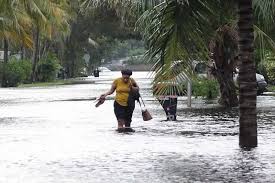By John Englander, Rising Seas Institute
Following the U.S. Presidential election, many pundits speculate that President Biden will use Executive Orders to deal with many issues that do not require Congressional legislation.
That would follow the precedent of both Presidents Trump and Obama. It raises an interesting question as to whether Executive Orders can affect flooding. Of course, flooding fundamentally comes from forces of nature, which residents of South Florida learned once again over the weekend.
Tropical Storm Eta dumped up to 14 inches of rain in western Broward County, a dousing that might have amounted to a once-in-100-years event, Robert Molleda, a Weather Service meteorologist, told the South Florida Sun Sentinel.

As the planet warms, scientists predict that we will have to cope with more tropical storms and that they’ll contain more water. Eta delivered that lesson over the weekend. Florida has been called “ground zero” in the United States for climate damage and 2020 has delivered the flooding to warrant that designation.
In recent decades it’s clear that rising seas are contributing to the increased flooding as the warming planet melts polar ice caps. In fact, there are two approaches for a President to try to reduce flooding: mitigation and adaptation.
Mitigation in this context refers to slowing the warming, by policies that might reduce carbon dioxide (CO2) in the atmosphere, one of the principal greenhouse gases. Executive Orders could well focus on that issue, perhaps regarding vehicle emissions standards, rule-making with the Environmental Protection Agency (EPA), encouragement of renewable energy, and other policies. Taken together, over decades, such policies can flatten the curve of rising CO2 emissions and eventually slow the warming. Over decades such policies can begin to reduce the problem of rising waters that cause worse flooding.
The second approach is adaptation. To reduce flooding we can raise buildings and infrastructure in Florida and other coastal areas. In the United States, building “codes” – the regulations – are typically set at the state and county level.

The President does not set them. But he can issue an Executive Order with regard to all federal buildings and infrastructure. In fact, President Obama did just that with an Executive Order. It directed that all federal new construction and major renovations would allow for an additional two feet of higher sea level; three feet for structures that were deemed critical. Also, the order used the 500-year flood plain as a reference point, far more conservative than the usual 100-year flood plain guideline.
Such an executive order to raise the design criteria for buildings and infrastructure has several virtues:
- With the vast property of the federal government, raising elevations in flood zones reduces the flooding potential, reducing damages, recovery expenses, and possibly fewer lives lost.
- Perhaps as important, such a leadership policy sets an example for all the states, municipalities, and private companies to emulate.
- Just the idea of following “best practices” helps professions such as architecture, engineering, and planning to consider incorporating in their own work and professions.
Presidential Executive Orders to raise the design criteria for federal buildings and infrastructure are perhaps the simplest way to reduce flooding that will have effect for decades and centuries.
While efficient and easy to implement, there is a weakness to Executive Orders however. They can be easily reversed by another administration. In fact, President Obama’s 2015 Executive Order #13690 was rescinded by President Trump’s Executive Order #13807 just two years later.
I think it’s reasonable to expect many Executive Orders under the new administration.
John Englander is an oceanographer and author of “High Tide On Main Street.” He is also President of the Rising Seas Institute, a new nonprofit think tank and policy center. This piece was adapted from his blog, John’s Blog.
“The Invading Sea” is a collaboration of four South Florida media organizations — the South Florida Sun Sentinel, Miami Herald, Palm Beach Post and WLRN Public Media.



